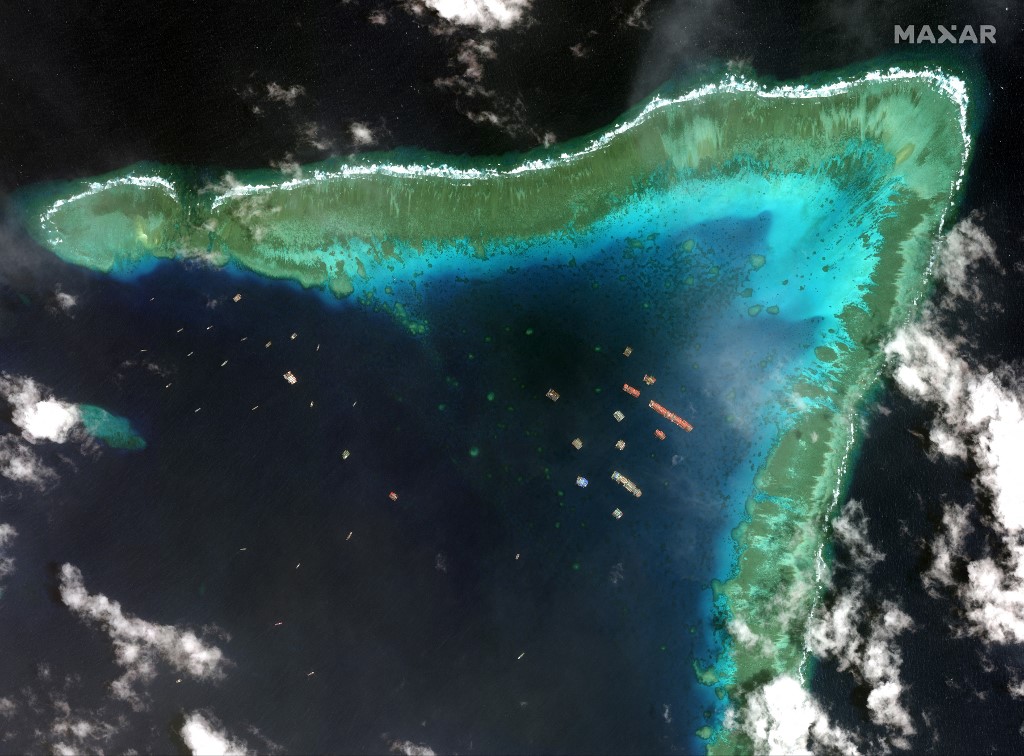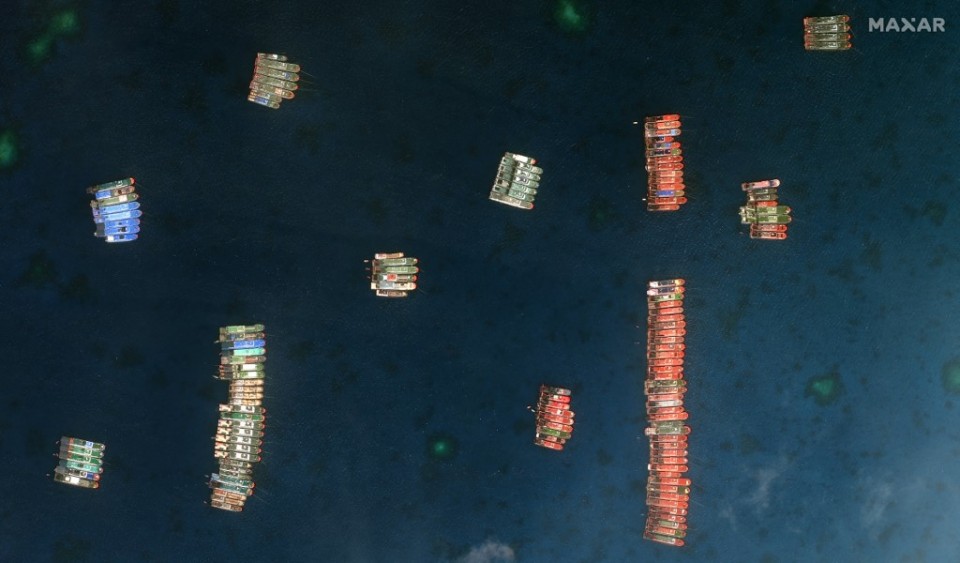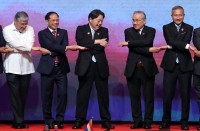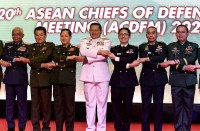Us-PHL-China intl relations and in’t l studies expert says PHL did right in sending PHL Coast Guard to ward off Chinese militia to avoid a repeat of Scarborough incident
(Eagle News) – China is using a tried and tested strategy of deploying its maritime militia in several land features such as reefs or shoals in the South China Sea, including those in the Philippines’ exclusive economic zone such as the Julian Felipe Reef (Whitsun Reef), as a prelude to occupying these if they could.
This is China’s SOP or Standard Operating Procedure of encroachment in the disputed seas, warned international studies expert Dr. Renato De Castro who is specializing on US-Philippines-China relations.
In an interview with Eagle News Service program Balitalakayan aired over NET25, Dr. De Castro said China is re-applying what it did in Scarborough Shoal in 2012. Philippine authorities should be on the alert on this China strategy because, according to De Castro, from what is happening right now, China is setting its sights on Julian Felipe Reef and the Kalayaan Group of islands.
De Castro said China’s maritime militia ships have been at the Julian Felipe Reef since three months ago.
“It took us some time before we were able to ascertain that they have been there for a long period of time, and hindi lang nag-se-shelter (and they’re not just there to take shelter),” De Castro told Balitalakayan anchor Weng Dela Fuente-Deimoy on Tuesday, March 31.
“It’s an indication of something, so dito bumabalik yung nangyari sa Scarborough Shoal,” he observed.
Way back 2012, it was also the Chinese maritime militia, eight Chinese fishing vessels, which were used by China to start its encroachment on Scarborough Shoal or “Panatag Shoal” which is just 198 kilometers west of Subic Bay in Zambales. The Philippines apprehended the Chinese fishermen using the Philippine Navy ship BRP Gregorio Del Pilar, prompting China to claim there was provocation, since a “gray ship” was sent by the Philippines to accost its fishermen. China claimed that this was a violation of international law, eventually leading to the stand-off.
“Eventually in-occupy nila ang Scarborough Shoal noong 2012. Ngayon kontrolado na nila, at maaari nilang tayuan yun ng artificial island. Pag meron na, lalagyan ng garrison, tulad ng nangyari sa Mischief Reef noong 1996,” De Castro said.
The use of Chinese maritime militia was also seen in Zamora Reef and seven other reefs which China had occupied since 1988, noted De Castro who is a full professor in the International Studies Department of De La Salle University, Manila, and holds the Charles Lui Chi Keung Professorial Chair in China Studies.
China will then build an artificial island, then a garrison to set its claim on small land structures or rock formations in disputed seas, he said.
–Learning from Scarborough –
“Natuto tayo sa Scarborough shoal. Ganyan yung unang nangyari. It was a trap by China,” he said.
Having learned our lesson, De Castro said that Defense Secretary Delfin Lorenzana is playing his cards right by sending the Philippine Coast Guard in the Julian Felipe Reef to ward off the Chinese maritime militia (CMM). Initially, there were as many as 200 Chinese militia boats near the reef in line formation. As of March 30, it had gone down to 44 after the diplomatic protest made by the Philippines’ Department of Foreign Affairs, and regular patrols by the Philippine Coast Guard, Bureau of Fisheries and Aquatic Resources (BFAR), with the Philippine Navy in the background.
“Tama yung desisyon ni Secretary Lorenzana to send the Philippine Coast Guard,” the professor said.
In this way, the Philippines is sending the message that “this is not a defense of the territory, this is more of law enforcement.” It’s teling China, “You’re violating our Exclusive Economic Zone.”
“Pag pinadala mo Navy, medyo provocative yan,” De Castro notes.
While the Philippine Coast Guard is there, our Philippine Navy is still on the background.
“Kasi ganun din naman ang ginagawa ng China e. In fact, sa pagsakop nila dito, hindi nila ginanamit yung Navy nila, yung People’s Liberation Army Navy, ginagamit nila yung kanilang maritime militia na of course deni-deny nila, pero makikita din natin nandyan yung Chinese Coast Guard” he said.
“Well, probably 12 to 20 nautical miles behind that, you will see the gray ships of the People’s Liberation Army (PLA) Navy.”
-China’s pattern in expansionism efforts in disputed seas –
This is their Standard Operating Procedure (SOP) as they acquire itong mga land features na ito,” De Castro said. And next is China building its artificial islands.
It’s a pattern, a strategy of China. By using the CMM or Chinese Maritime Militia, China is trying to play safe at first, using the CMM and the claim that they are mere Chinese fishing boats.
“So nakikita natin yung pattern na ito. Yung ginagamit nila yung something that they could deny, the Chinese maritime militia. They could always deny that they exist,” De Castro told Eagle News Service’s Balitalakayan.
“But everyone knows that China formed this militia from ordinary fishing boats in coastal areas in China. Ito ay maaaring umpisa sa pag-control sa Julian Felipe Reef,” he observed.
“Eventually tatayuan nila ng artificial island, katulad ng nangyari sa Zamora Reef, sa Mischief Reef and seven other reefs na in-occupy nila since 1988.”
They will put then their garrisons, their radars, other communication equipment, to establish the so-called “facts on the ground,” he said.
Prof. De Castro studied China’s actions and knows whereof he speaks.
Aside from holding the Charles Lui Chi Keung Professorial Chair in China Studies, De Castro is also the U.S.-ASEAN Fulbright Initiative Researcher from the Philippines and was based in the East-West Center in Washington D.C. from September to December 2016. He is a alumnus of the Daniel Inouye Asia-Pacific Center for Security Studies in Hawaii, U.S.A. In 2009, Dr. De Castro became the U.S. State Department ASEAN Research Fellow from the Philippines and was based in the Political Science Department of Arizona State University. He earned his Ph.D. from the Government and International Studies Department of the University of South Carolina as a Fulbright Scholar in 2001, and obtained his B.A. and two master’s degrees from the University of the Philippines. He has also conducted several courses on International Relations and Security Studies in the National Defense College and Foreign Service Institute, and is also a member of the Board of Trustees of the Albert Del Rosario Institute for Strategic and International Studies (ADR Institute). He is also a consultant in the National Security Council of the Philippines during the Aquino Administration.
His research interests include Philippine-U.S. security relations, Philippine defense and foreign policies, U.S. defense and foreign policies in East Asia, and the international politics of East Asia. He has also written over 80 articles on international relations and security that have been published in a number of scholarly journals and edited works in the Philippines, South Korea, Canada, Malaysia, France, Singapore, Taiwan, Germany, the United Kingdom, Australia, and the United States.
-China’s plans-
“Planado na yan. Ang tingin ng China dyan, amin na yan. Kaya nga may nine dash line,” De Castro observes of China’s recent actions.
But this time, China is even going out of their so-called nine dash line, he said.
“Ang nakapagtataka rin, yung area na yan, hindi yan sakop ng nine-dash line,” he said referring to China’s often-used historical claim on almost the entire South China Sea.
“Binabasa ko yung mga Chinese communique. May ginagamit na silang terms na relevant waters. Ibig sabihin interesado na sila dito,” De Castro said.


He said China wants to control most of the South China Sea and transform this as part of its “territorial waters”.
“Their agenda is to effect 85 percent control of the South China Sea, to transform this water into their buffer against the US Seventh Fleet, and of course the navies of other countries,” De Castro said.
“It’s a matter of ‘fait accompli.’ We could delay this by standing up and hopefully getting international assistance,” he said.
So far, De Castro noted that China plans to apply this SOP or pattern in the Julian Felipe reef.
“What has been indicated here is that maaari nilang gawin ulit itong artificial island, then eventually, ilalagay nila yung garrison nila, yung radars nila, communication equipment, parai-effect yung tinatawag nilang facts on the ground,” he warned.
-PHL standing its ground-
De Castro said it is important for the Philippines this time to stand their ground, be on the alert and use its wits since China has been consistent in its belief that “might makes right.”
China, in fact, does not give a hoot about the Philippines’ win in the International Arbitral Tribunal in The Hague in 2016.
For China, this is “a little more than scrap papers,” De Castro notes citing how China’s foreign policy chief Yang Jiechi described the arbitral ruling to US Secretary of State Antony Blinken and US national security adviser Jake Sullivan in a recent meeting in Alaska.
China completely ignored the ruling, De Castro said.
“Because they have everything in their favor. They have of course the naval capability. They have the Chinese Coast Guard. They have the maritime militia, and of course China has the second largest economy in the world.”
-De Castro: How should China behave as an emergent power in the Indo-Pacific region?
China has not yet stated which waters are actually in their so-called nine-dash line. But China’s plan is to declare that the areas inside the nine-dash line are considered part of their territorial waters, De Castro said.
Once China pushes through with this, ships cannot cite right to innocent passage to traverse these areas, unlike if these were under the so-called EEZ. Entry into these waters has to have China’s permission.
This is something that should be prevented, De Castro said, describing this as a “generational challenge.”
“This issue will be a generational challenge not only for Filipinos, but also for Chinese, Americans and Japanese,” De Castro said. “This will be a lingering issue.”
“It is not a simple territorial dispute. Ang bottom line dito, ang issue dito is ‘how should China behave as an emergent power in the Indo-Pacific region?'”
-US support for PHL assured-
Even the United States, under the administration of former President Donald Trump, saw through China, he said, with the US saying that China could not be trusted to be a responsible stakeholder in the Indo-Pacific region, and that China is even threatening the rules-based international order that the US and its allies established after World War II.
In 2017, the Trump administration had made a policy shift as to how to treat China, from being viewed as a strategic partner to a “strategic competitor.”
This policy is also what the Biden administration plans to follow, De Castro notes.
-China’s dilemma-
China has built its naval and air force capability but has not yet tested its power in combat.
The last time that China did so, going into war, was with Vietnam in 1979 where it suffered losses. Both Vietnam and China lost thousands of lives in that war in 1979 when China conducted a limited attack on Vietnam. Among the reasons cited for China’s attack in Vietnam then was to support China’s ally, the Khmer Rouge of Cambodia, and as retaliation to the alleged mistreatment of Vietnam’s ethnic Chinese minority, and the Vietnamese occupation of the Spratly Islands which China was also claiming.
“They (China) suffered horrendous casualties when they tried to punish Vietnam,” De Castro said.
So this is the dilemma of the Chinese military leadership and even of Chinese President Xi Jinping who heads the military commission, he said. China has built up its powerful military, including its air and navy assets, but China has not been tested these yet.
Last year, it fired intermediate range missiles from Western China. “But the question here is will this work under an actual war situation?” De Castro asked.
“Iba na yan pag meron nang actual clash of arms. Iba na yan,” he said. That is when you will know what works, and what doesn’t work, he said.
More recently, US Secretary of State Blinken reiterated the United States’ support for the Philippines in case China becomes aggressive at the Whitsun Reef or the Julian Felipe Reef.
In no uncertain terms, he assured this in a recent tweet.
Blinken said: “The United States stands with our ally, the Philippines, in the face of the PRC’s maritime militia amassing at WhitsunReef. We will always stand by our allies and stand up for the rules-based international order.”
The United States stands with our ally, the Philippines, in the face of the PRC’s maritime militia amassing at WhitsunReef. We will always stand by our allies and stand up for the rules-based international order.
— Secretary Antony Blinken (@SecBlinken) March 28, 2021
“Our alliances were created to defend shared values. Renewing our commitment requires reaffirming those values and the foundation of international relations we vow to protect: a free and open rules-based order,” he added.
Our alliances were created to defend shared values. Renewing our commitment requires reaffirming those values and the foundation of international relations we vow to protect: a free and open rules-based order. pic.twitter.com/5x9vgn4YdQ
— Secretary Antony Blinken (@SecBlinken) March 28, 2021
In the face of this assurance from the US of military support, is China prepared to test its naval and air power over its ambition to control more of the South China Sea?
That is the 1 million dollar question, De Castro said.
(Eagle News Service)







